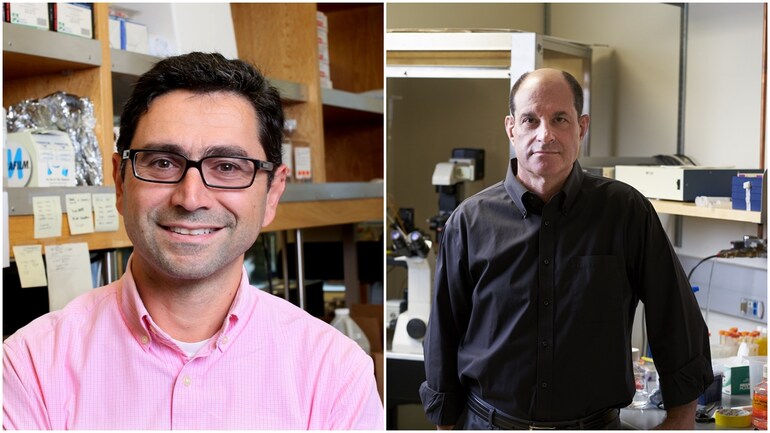The Nobel Prize in Physiology or Medicine 2021
David Julius of USA and Ardem Patapoutian of Lebanon were
jointly awarded the Nobel Prize in Physiology or Medicine in 2021 "for
their discovery of temperature and touch receptors." David Julius was born
on 4 November 1955, New York, NY, USA. He is currently affiliated with
University of California, San Francisco, CA, USA. Ardem Patapoutian was born in
1967, Beirut, Lebanon. Current affiliation at the time of the award is at Howard
Hughes Medical Institute, Scripps Research, La Jolla, CA, USA.
Our capacity to feel warmth, coldness, and touch is critical
for life and supports how we engage with the environment. We take these
sensations for granted in our everyday lives, but how do nerve impulses
originate temperature and pressure perception? The Nobel Laureates for this
year have answered those questions.
David Julius used capsaicin, a pungent substance found in
chilli peppers that causes a burning sensation, to find a heat-sensitive sensor
in the skin's nerve endings. Ardem Patapoutian discovered a new class of
sensors that react to mechanical stimuli in the skin and interior organs using
pressure-sensitive cells. These groundbreaking discoveries sparked a flurry of
study, resulting in a fast improvement in our knowledge of how our nervous
system perceives heat, cold, and mechanical stimuli. The laureates discovered
important gaps in our knowledge of the complicated interplay between our senses
and our surroundings.
By examining how the chemical component capsaicin creates the
burning sensation we feel when we come into touch with chilli peppers, David
Julius of the University of California, San Francisco, recognised the potential
for huge breakthroughs. Capsaicin was already known to stimulate nerve cells,
creating pain feelings, but exactly how this molecule did so remained a
mystery. Julius and his colleagues constructed a database of millions of DNA
fragments belonging to genes expressed in sensory neurons that respond to pain,
heat, and touch. Julius and colleagues expected that the library would contain
a DNA fragment encoding a capsaicin-reactive protein. Individual genes from
this collection were expressed in cultivated cells that do not ordinarily react
to capsaicin. After a long search, a single gene was discovered that may make
cells sensitive to capsaicin. The capsaicin-sensing gene had been discovered!
Further research found that the identified gene encoded an unique ion channel
protein, which was dubbed TRPV1 after the recently discovered capsaicin
receptor. Julius identified a heat-sensing receptor that is activated at
temperatures that are felt as painful when he looked into the protein's
capacity to respond to heat.
Study under pressure
Whereas the processes for temperature sensation were being
discovered, it was still unknown how mechanical impulses might be transformed into
our tactile and pressure perceptions. Mechanical sensors had already been
discovered in bacteria, but the processes that underpin touch in vertebrates
were unclear. Ardem Patapoutian, a researcher at Scripps Research in La Jolla,
California, wanted to find out which receptors are triggered by mechanical
stimulation.
As individual cells were pushed with a micropipette,
Patapoutian and his coworkers discovered a cell line that gave off a
quantifiable electric signal. The receptor triggered by mechanical force was
considered to be an ion channel, and 72 candidate genes encoding potential
receptors were discovered as a further step. To find the gene responsible for
mechanosensitivity in the cells tested, these genes were inactivated one after
another. Patapoutian and his colleagues identified a single gene whose
silencing rendered the cells unresponsive to pushing with the micropipette
after a long search.
Patapoutian's
revelation sparked a flurry of studies from his and other organisations
revealing that the Piezo2 ion channel is critical for touch perception.
Furthermore, Piezo2 has been demonstrated to play a fundamental part in the
crucial sense of body position and motion known as proprioception. Piezo1 and
Piezo2 channels have also been demonstrated to govern other essential
physiological processes such as blood pressure, respiration, and urine bladder
control in subsequent studies.
This year's Nobel Laureates' significant discoveries of the
TRPV1, TRPM8, and Piezo channels have helped us to better grasp how heat, cold,
and mechanical force may trigger nerve impulses which permit us to detect and
adapt to new environments around us. Our capacity to detect temperature is
largely dependent on TRP channels. The Piezo2 channel gives us the capacity to
feel touch as well as the location and movement of our body parts.
TRP and Piezo channels also play a role in a variety of other
physiological activities that rely on temperature or mechanical inputs for detection.
Intensive continuing research centred on clarifying their involvement in a
number of physiological processes stemming from this year's Nobel Prize-winning
findings. This understanding is being applied to the development of medicines
for a variety of diseases, including chronic pain.



No comments:
Post a Comment